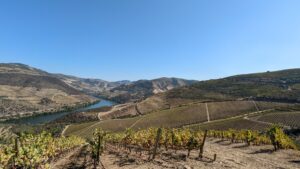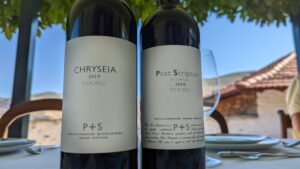No set of eyes conveyed the paradoxical characteristics of exhaustion and electricity more than the man who surveyed the wine grape bunches on the vines with a fierce intensity. At any moment, this winemaker, with his weary, electric eyes, would have to throw it into high gear to get his team together to harvest within an hour’s notice as grapes destined for a stellar wine cannot wait in the Douro Valley, unlike other fine wine regions which can, many times, schedule a week or so out. And with every examination that takes place along the vineyard rows, there is a mixed feeling of hoping for a sign that would allow him to start picking the grapes, finally being able to release his team from their frustrating purgatory, contrasted by a potential feeling of euphoria when he finds out that his most highly-regarded variety, Touriga Nacional, will be able to stay on the vines longer, ultimately increasing the chances of an excellent vintage.
But this is the Douro Valley, tucked away in the mountainous Upper Douro Valley in north-eastern Portugal, and its extreme viticulture is like no other as vines grow on rocky soils, steep slopes, have little access to water (low rainfall and many vineyards cannot be irrigated) and grow within century-old vineyard terraces that always need maintenance. Outstanding fortified Port wines have been a big part of its fine wine legacy and, in recent years, high-quality big, robust, non-fortified red wines; yet in some spots, the Douro is capable of a delicate beauty and pure expression of place that is breathtaking considering the various aspects of its terroir.
The wines that have those exquisite characteristics of delicate beauty and pure expression come from the Quinta de Roriz and Quinta da Perdiz properties; Roriz is located on the South bank of the river Douro in the heart of the Upper Douro region, where a natural north-facing amphitheater that reaches up to 1,500 feet in altitude is located and Perdiz lies on a steep gradient on the other side of the same mountain. The Symington family, who first became part of the Port world in the Douro back in the 1880s, started to experiment with making non-fortified wines back in the 1990s, as Port is fortified with a neutral spirit in the middle of its fermentation. They wanted to show the world beyond Port drinkers the extraordinary sense of place of the Douro Valley. The Symington Family Estates, which is 100% family-owned and family-run – unfortunately becoming a rarer situation in today’s time – started to experiment among their many estates in the Douro to see if it was possible to make a non-fortified wine that could not only live up to their most outstanding fortified Port Vintage wines but could also compete with the great non-fortified wines of the world.
Finally, Rupert Symington and his cousin Charles Symington, CEO and head winemaker at Symington Family Estates, respectively, not only found an ideal partner in this venture, Bruno Prats, former owner of “super-second” Château Cos d’Estournel in Bordeaux, but found the perfect vineyards on the Quinta de Roriz and Quinta da Perdiz estates. Roriz has traces of tin intermixed within the schistous soil from an old mine at the highest point of the estate, and hence, is said to give a strong minerality to the fruit grown on the property as well as its north-facing position ensures to retain aromatics; as opposed to Perdiz, on the other side of the same mountain, has a warmer micro-climate that produces fruit that makes ripe, velvety wines.
Chryseia
The Prats and Symington families purchased the Roriz and Perdiz estates around 20 years ago, the Prats family contributing expertise in making one of the most excellent red wines in the world as Bruno Prats is credited with bringing Cos d’Estournel to true “super-second” status. The Symington family brings their expertise of the Douro Valley as they have lived and breathed these vineyards for almost a century and a half.
Rupert and Charles Symington had been experimenting with an array of different varieties from their various prime estates throughout the Douro, but the Touriga Nacional and Touriga Franca red grape varieties from the Roriz and Perdiz properties were the ideal combination for a wine that showed a potential for outstanding quality. And hence, the ‘Chryseia’ wine was born, which means “golden” in ancient Greek, and it is also a play on the word “Douro,” meaning “golden” in Portuguese. Subsequently, a second selection, ‘Post Scriptum’, as well as a third selection, ‘Prazo de Roriz’, that is 100% sourced from the Quinta de Roriz estate, were created.
Unlocking Pure Expression of a Place
It has been a journey of discovery for both the Prats and Symington families as well as for many other wine producers in the area, as the Douro Valley was seen as a place that should only make great Port wine and, in special circumstances, great big, bold red wines; the elegant wines of ‘Chryseia’ took many aback with initial criticism thrown at this extraordinary project. But these legendary wine families were determined to show the nuanced sense of place without using techniques in the winery that would over-extract the wine, which is a key to many other great wines in the Douro. Even Bruno Prats, who had his own past challenges with his Cos d’Estournel estate, proving to the world that it deserved to be considered on a par with the First Growth wines – which has become a reality today, was completely surprised how the vineyards that make up the ‘Chryseia’ wine could not only survive in periods of intense heat without any water but that the vines thrived and produced exquisite fruit that had a subtle beauty and distinctive sense of place.
Miguel Bessa, winemaker of Quinta de Roriz and the ‘Chryseia’ wines, says that the 2020 vintage, the warmest year of the century in the Douro, as well as 2022, which may surpass 2020, have both proved that they can still make outstanding wine that is equal to more moderate years, which gives them a lot of reassurance for the future because he feels that even though the Douro wine region has “300 years of knowledge in taking care of their vines,” the ‘Chryseia’ wines’ goal is different in aiming for an elegant red wine, as opposed to making Port. So they have only had 20 years of experience with this goal which is a small amount of time, although they have made significant improvements with the wines and how they manage the vines; and Miguel feels that there is still room for improvement and looks forward to this project becoming the ideal way to showcase the depth of complexity that happens when they unlock the terroir expression in some of the region’s best vineyards.
Miguel has even started experimenting with non-Saccharomyces yeast to ferment a few of his wine vats (Saccharomyces is the yeast most commonly used for wine ferments) to enable him to use less sulfur and potentially allow the wine to greater express a sense of place. As he finds that there is no risk of spoilage yeast, which could create unpleasant aromas, taking over when using non-Saccharomyces hence he doesn’t need to use as much sulfur – but time will tell. It may be another leap in taking these wines to an even more extraordinary level.
A Wine Representing the Soul of the People
But nothing could ever take the place of Miguel’s eagle eyes constantly walking up and down the vineyard rows combined with his crew ready to jump into action at any moment, as yes, they do pay the price in the hottest years with losses in yields that are anywhere between 20% to 30%, yet it is their unwavering commitment that keeps enough of the grapes at a high-quality level that is worthy for the ‘Chryseia’ project. That is why Miguel lives at Quinta de Roriz during harvest, not returning home for over a month, if not longer.
Many give Miguel so much credit and note that it is his team and especially Miguel himself who make this project possible, but such praise makes Miguel uncomfortable as he is a quintessential Portuguese person who shuns the limelight as the culture expects people to keep their head down and to not stand out in any way. His softly spoken words are indicative of the finely textured structure of his wines and his depth of thought and quiet intelligence is also evident. In a way, the ‘Chryseia’ wines, with their overall finesse, really do reflect the soul of the place, although the wines may go against the more traditional idea of making red wines that are reminiscent of Port. But the ‘Chryseia’ wines give the drinker a chance to not only experience an incredible terroir but also to truly experience the physically and mentally tough people who work in some of the most extreme vineyards in the world yet despite the arduous work, they are some of the gentlest people who have the patience to continue the precision necessary to make fine wine in the Douro Valley consistently.
***Link to original article on Forbes: https://www.forbes.com/sites/cathrinetodd/2022/10/14/famous-bordeaux-wine-family-partners-with-historic-port-family-creating-an-elegant-wine-with-a-unique-terroir/
2019 Prazo de Roriz, Douro Valley, Portugal: 35% Touriga Nacional, 20% Touriga Franca, 15% Tinta Roriz, 10 % Tinta Barroca and 20% mixed varieties; third selection of Chryseia. This wine is overall fresh and bright with lovely strawberry fruit and stony minerality and a soft texture.
2020 Post Scriptum de Chryseia, Douro Valley, Portugal: 51% Touriga Franca, 34% Touriga Nacional with Tinta Roriz and Tinta Barroca making up the rest of the blend; second selection of Chryseia. Pristine red cherries with wet river stones and hints of baking spices on the nose with excellent vitality on the palate with fresh red fruit intermixed with broken gravel.
2019 Chryseia, Douro Valley, Portugal: 75% Touriga Nacional and 25% Touriga Franca. This vintage should be arriving in the U.S. soon and it is a stunning beauty already even though it is far from improving in bottle and it will easily last at least 20 years, if not longer. Pretty lifted aromas such as rose oil intermixed with complex notes of tar, tobacco leaf and crushed rocks with a finely etched tannic structure highlighted with subtle blackcurrant fruit and a long, expressive finish.
2020 Chryseia, Douro Valley, Portugal: Do not have the breakdown of the varieties, but it is majority Touriga Nacional blended with Touriga Franca. Also, this wine is still aging so it will not be released on the market until next year. Intense minerality with notes of graphite and turmeric spice balanced by rich blackberry preserves with a slight tannic grip that gives a lift to the lush fruit finishing with aromas of wildflowers. Surprising how delicious this wine is already at this stage.
2009 Chryseia, Douro Valley, Portugal: 70% Touriga Nacional and 30% Touriga Franca. Bright acidity with a smoky minerality that has enticing notes of espresso and ripe raspberry intermixed with crushed rose petal, rosemary and zingy cranberry that has a lot of tension. So complex and multi-layered.
2015 Chryseia, Douro Valley, Portugal: 65% Touriga Nacional and 35% Touriga Franca. Silky tannins and good fleshy black fruit on the palate are enhanced by notes of orange rind, cocoa powder, and the development of cigar box notes with a breathtaking overall quality of refinement.
2017 Chryseia, Douro Valley, Portugal: 75% Touriga Nacional and 25% Touriga Franca. Beautiful mineral purity on the nose accompanied by aromas of jasmine and spice has juicy cassis flavors with a fine texture that caresses the palate. A wonderful example of concentration and overall finesse – awe-inspiring.















